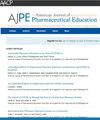Evaluating Instructional Efficiency in a Flipped Classroom: A Pilot Study in a Pharmacotherapy Course
IF 3.5
4区 教育学
Q1 EDUCATION, SCIENTIFIC DISCIPLINES
引用次数: 0
Abstract
Objective
This study aims to evaluate the instructional efficiency of preclass learning materials in an integrated pharmacotherapy course, using mental effort and assessment performance as metrics.
Methods
This pilot study was conducted in a required pharmacotherapy course that uses a flipped classroom approach. Third-year PharmD students completed preclass learning activities across 6 different modules and 2 sections during the Fall 2024 semester. Preclass materials primarily consisted of readings and guided learning questions. Mental effort, measured using the Paas scale, and performance on individual readiness assurance tests were standardized and used to calculate the instructional efficiency of preclass materials for each module. Data were used to inform decision-making related to course quality improvement.
Results
A total of 129 students participated, with a response rate greater than 90% for the mental effort survey. Assessment performance data were available for all students. Instructional efficiency scores identified less efficient topics, such as atrial fibrillation and acute coronary syndrome, as areas for quality improvement. Efficiency graphs compared instructional efficiency across modules and sections, highlighting specific areas in need of refinement.
Conclusion
Preclass learning is essential but challenging in flipped classrooms. Instructional efficiency measures can support quality improvement by identifying inefficient learning tasks. Efficiency data can guide decision-making and allow for year-over-year comparisons of course topics. Strategies informed by cognitive load theory and motivational theory can improve instructional efficiency and promote student success.
评价翻转课堂教学效率:药物治疗课程的试点研究。
目的:本研究以心理努力和评估成绩为指标,评价综合药物治疗课程课前学习材料的教学效果。方法:本试点研究在一门使用翻转课堂方法的必修药物治疗课程中进行。2024年秋季学期,药学博士三年级学生完成了六个不同模块和两个部分的课前学习活动。课前材料主要包括阅读材料和指导性学习问题。心理努力(使用Paas量表)和个人准备保证测试的表现被标准化,并用于计算每个模块的课前材料的教学效率。数据被用来告知与课程质量改进相关的决策。结果:共有129名学生参与,心理努力度调查的回复率为90%。所有学生均可获得评估表现的数据。教学效率评分确定了效率较低的主题(如心房颤动、急性冠状动脉综合征),以提高教学质量。效率图表比较了各个模块和部分的教学效率,突出了需要改进的地方。结论:在翻转课堂中,课前学习至关重要,但也具有挑战性。教学效率度量可以通过识别低效的学习任务来推动质量的提高。效率数据可以为决策提供信息,并使年度主题能够进行比较。从认知负荷和动机理论出发的策略可以提高教学效率,促进学生成功。
本文章由计算机程序翻译,如有差异,请以英文原文为准。
求助全文
约1分钟内获得全文
求助全文
来源期刊
CiteScore
4.30
自引率
15.20%
发文量
114
期刊介绍:
The Journal accepts unsolicited manuscripts that have not been published and are not under consideration for publication elsewhere. The Journal only considers material related to pharmaceutical education for publication. Authors must prepare manuscripts to conform to the Journal style (Author Instructions). All manuscripts are subject to peer review and approval by the editor prior to acceptance for publication. Reviewers are assigned by the editor with the advice of the editorial board as needed. Manuscripts are submitted and processed online (Submit a Manuscript) using Editorial Manager, an online manuscript tracking system that facilitates communication between the editorial office, editor, associate editors, reviewers, and authors.
After a manuscript is accepted, it is scheduled for publication in an upcoming issue of the Journal. All manuscripts are formatted and copyedited, and returned to the author for review and approval of the changes. Approximately 2 weeks prior to publication, the author receives an electronic proof of the article for final review and approval. Authors are not assessed page charges for publication.

 求助内容:
求助内容: 应助结果提醒方式:
应助结果提醒方式:


